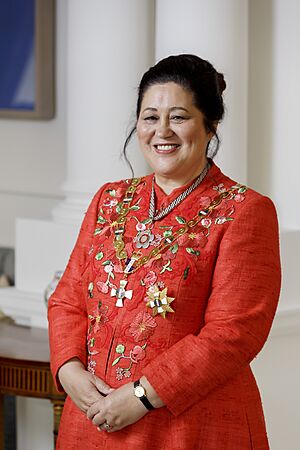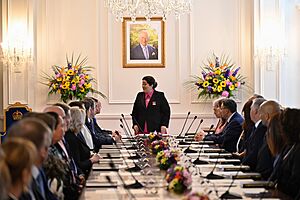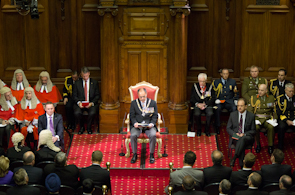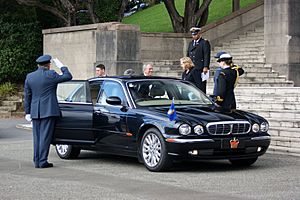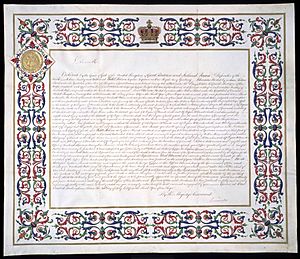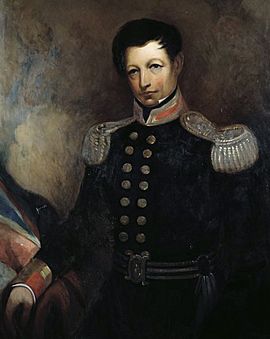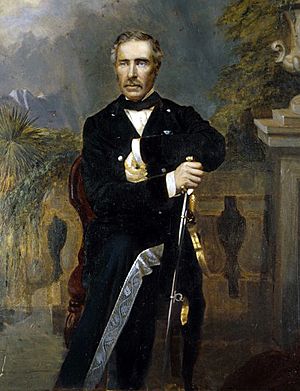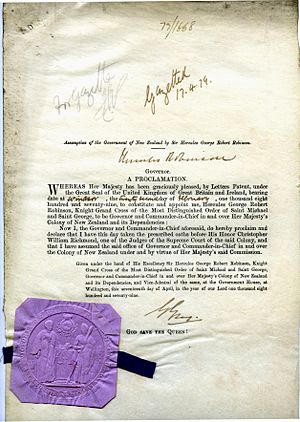Governor-General of New Zealand facts for kids
Quick facts for kids Governor-General of New Zealand |
|
|---|---|

|
|

Badge
|
|
| Viceregal | |
| Style | Her Excellency The Right Honourable |
| Residence | Government House, Wellington Government House, Auckland |
| Seat | Wellington, New Zealand |
| Appointer | Monarch of New Zealand
on the advice of the prime minister
|
| Term length | At His Majesty's pleasure
(usually 5 years by constitutional convention)
|
| Constituting instrument | Letters Patent 1983 |
| Formation | 3 May 1841 |
| First holder | William Hobson as Governor of New Zealand |
| Salary | NZ$440,000 annually |
| Website | Governor-General of New Zealand |
The governor-general of New Zealand (Māori: Te kāwana tianara o Aotearoa) is the King's representative in New Zealand. The current monarch is King Charles III. Since the King lives in the United Kingdom and is also monarch of 14 other countries, he appoints a governor-general. This person carries out his important duties in New Zealand.
Governors-general usually serve for five years. They formally serve "at the monarch's pleasure". This means the King can extend or end their term. The current governor-general is Dame Cindy Kiro. She has held the role since 21 October 2021. The Department of the Prime Minister and Cabinet helps the governor-general with their work.
The governor-general has several important jobs. These include leading the Executive Council. They also appoint ministers and judges. They give royal assent to new laws, making them official. They can also call or end parliamentary sessions. These duties are usually done following the advice of the elected government. The governor-general also has many ceremonial roles. They host events at Government House. They travel around New Zealand to open conferences and attend special events. They encourage people and groups who help their communities.
The role began when New Zealand was part of the Colony of New South Wales in 1839. New Zealand became its own colony in 1840 with its own governor. The title "governor-general" and its modern duties started in 1917. The office is now guided by Letters Patent issued in 1983. These documents describe the "Governor-General and Commander-in-Chief of the Realm of New Zealand". In the past, the governor represented both the British monarch and the British government. Many early officeholders were from the United Kingdom. Over time, especially after the Statute of Westminster was adopted in 1947, the governor-general became the independent representative of the New Zealand monarch. In 1972, Sir Denis Blundell was the first New Zealander to be appointed. When traveling overseas, the governor-general represents New Zealand as a nation. Because of this, some people see the governor-general as the de facto (in practice) head of state. However, the Constitution Act 1986 clearly states that the monarch is New Zealand's head of state.
How the Governor-General is Chosen
The monarch of New Zealand appoints the governor-general. This happens only after the prime minister of New Zealand recommends someone. The appointment is made official with a document called the "Terms of Appointment".
In 1930, a new rule was agreed upon at the Imperial Conference. This rule allowed the governor-general to be appointed based on the advice of the New Zealand Government. However, a New Zealand prime minister did not directly use this right until 1967. That year, Sir Arthur Porritt, the first New Zealand-born governor-general, was appointed on the advice of Keith Holyoake. The next governor-general, Sir Denis Blundell, was the first New Zealander born and living in New Zealand to hold the role. Today, the prime minister signs the Terms of Appointment. This shows that the prime minister is responsible for advising the King on the appointment.
Sometimes, the prime minister's advice comes from a decision made by the Cabinet (a group of senior ministers). However, this is not always required. Since 1980, the Department of the Prime Minister and Cabinet creates a list of possible candidates. Usually, the leader of the Opposition is asked for their opinion on the appointment. But this has not always happened.
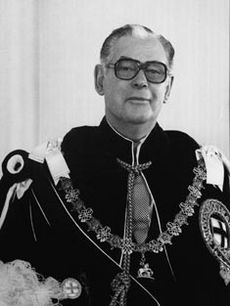
Only once has a prime minister's choice caused public debate. In 1977, Sir Keith Holyoake, a former prime minister, was appointed. The Leader of the Opposition, Bill Rowling, complained he was not consulted. He suggested Sir Edmund Hillary instead. Many people thought it was not right to give the job to a former party leader. Despite this, Holyoake performed his duties fairly. He stayed in office for three years. Since then, the prime minister is expected to talk with the leader of the opposition. This helps avoid political arguments. The decision is kept secret until both the New Zealand Government and Buckingham Palace announce it.
Since 1980, many lawyers and judges have become governors-general. After the introduction of MMP (Mixed-member proportional representation) in 1996, understanding constitutional law became very important for the role. Sir Michael Hardie Boys, a retired high court judge, was the first governor-general to oversee an MMP general election. He was appointed in 1995.
There has been talk about a member of the royal family becoming governor-general. In 2004, a politician asked if the Queen's son, Prince Edward, Earl of Wessex, had been considered.
Swearing-in Ceremony
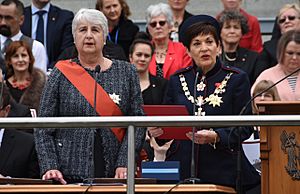
Before the governor-general starts their job, their appointment document is read publicly. This happens in front of the chief justice and members of the Executive Council. Then, the chief justice or another High Court judge gives the governor-general two oaths: the Oath of Allegiance and the Oath of Office.
Ideas for Electing the Governor-General
Sometimes, people suggest that the governor-general should be elected. In 1852, an early version of the New Zealand Constitution Act 1852 included a plan for parliament to elect the governor. This idea was removed. In 1887, Sir George Grey, a former premier, tried to make the governor's job an elected one. His bill was narrowly defeated.
In 2006, a political writer suggested that parliament could elect the governor-general with a 60 percent majority. He argued that New Zealanders should choose the King's representative. This system is used in countries like Papua New Guinea and the Solomon Islands. However, some experts worry that an elected governor-general might become a political rival to the prime minister.
In 2008, a group supporting a New Zealand republic suggested electing the governor-general. They saw this as a step towards becoming a republic. In 2010, during discussions about a new law for the governor-general, a Green Party MP suggested parliament recommend the next governor-general to the Queen. This recommendation would need approval from three-quarters of parliament.
How Long the Governor-General Serves
The governor-general holds office "at His Majesty's pleasure". This means the King can decide how long they serve. Usually, a person holds the office for at least five years. However, this term can be extended. For example, Dame Silvia Cartwright's term was extended by four months in 2006. This was so the process of choosing a new governor-general would not happen during the election period.
Acting Governor-General
If the governor-general resigns, dies, becomes unable to serve, or leaves New Zealand, the chief justice (currently Helen Winkelmann) steps in. They become the administrator of the Government and perform the governor-general's duties. The administrator must take a similar oath. If the chief justice is not available, the next most senior judge takes on the role.
Ending the Governor-General's Term
The prime minister can advise the monarch to dismiss the governor-general. No New Zealand governor-general has ever been dismissed this way. It is not clear how quickly the monarch would act on such advice. Some experts believe the monarch would follow the prime minister's advice. Others think they might delay it.
Critics say this system gives both the prime minister and the governor-general the power to dismiss each other. They argue this is a weakness in New Zealand's government structure.
Three governors were dismissed in the 1800s: William Hobson, Robert FitzRoy, and Sir George Grey. They were dismissed on the advice of the British government, before New Zealand had its own responsible government.
What the Governor-General Does
The governor-general's duties fall into three main areas: constitutional, ceremonial, and community. By tradition, the governor-general stays "above party politics". They are not involved in the daily decisions of the government.
Constitutional Role
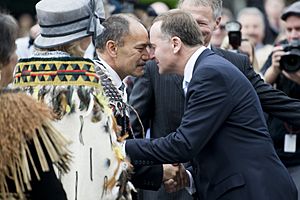
The Constitution Act 1986 states that the governor-general is the King's representative in New Zealand. The King's royal powers, known as the Royal Prerogative, are given to the governor-general. This includes special "reserve powers". All the King's executive power in New Zealand (except appointing the governor-general) is given to the governor-general. This is done through the Letters Patent 1983.
When the King is in New Zealand, he can use his powers himself. The governor-general is the official chief executive. However, their powers are very limited in practice. Most political power is used by the New Zealand Parliament. This includes the Governor-General-in-Parliament and the House of Representatives. The prime minister and Cabinet exercise most power. The governor-general uses their powers almost always on the advice of the prime minister and other ministers. Ministers are responsible to the elected House of Representatives. The governor-general can refuse to follow ministerial advice only if the prime minister loses the support of the House of Representatives. Even when appointing a prime minister, the governor-general usually appoints the leader of the largest party.
Role in Government
The governor-general appoints and dismisses Cabinet ministers. But they only do this on the prime minister's advice. So, the prime minister controls who is in the Cabinet. The governor-general could, in theory, dismiss a prime minister. However, tradition prevents such an action.
The governor-general leads the Executive Council of New Zealand. This council includes Cabinet and non-Cabinet ministers. It meets to make Cabinet decisions legally binding. The main job of the Executive Council is to advise the governor-general to issue Orders in Council. These orders create regulations or appointments.
The governor-general also keeps the Seal of New Zealand. This seal is used for all official documents of the New Zealand Government.
Role in Parliament
The governor-general calls and ends the New Zealand Parliament sessions. Each new session begins with the governor-general's call. The session starts with the opening of parliament. During this, the governor-general gives the 'Speech from the Throne'. This speech outlines the Government's plans for new laws. Ending a parliamentary term is called dissolution. This is followed by a general election. These powers are almost always used on the prime minister's advice. The prime minister also decides the election date. The governor-general could, in theory, refuse to end a session. But the reasons for doing so are not clear.
Before a bill can become law, it needs Royal Assent. The governor-general acts for the King and grants Royal Assent. This makes the bill a law. By modern tradition, Royal Assent is always given. Laws become effective when the governor-general signs the bill.
Special Powers
The governor-general acts on the prime minister's advice. This is unless the prime minister has lost the support of the House of Representatives. These are called 'reserve powers'. They include the power to:
- End or suspend parliament.
- Appoint or dismiss the prime minister.
- Refuse a prime minister's request to end parliament.
- Refuse to approve new laws.
The use of these powers is often debated. Some experts believe the governor-general cannot refuse to approve laws. Others think the governor-general can refuse in very unusual situations. For example, if democracy itself was being abolished. The Parliamentary Library notes that the power to refuse approval has become ineffective due to tradition.
The governor-general's use of these special powers cannot be challenged in court. This is different from the actions of other government members.
Power to Grant Mercy
The governor-general also has the royal prerogative of mercy. This is an old right for convicted people to ask for their case to be reviewed. This happens if they believe an injustice occurred.
The governor-general acts on the advice of the minister of justice. The governor-general can grant a pardon. They can also send a person's case back to the court. Or they can reduce a person's sentence. If a case goes back to court, the court reviews it like an appeal. The court then advises the governor-general on what to do.
Ceremonial Role

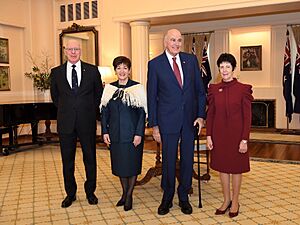
Since most constitutional duties are handled by the government, the governor-general focuses on representing New Zealand. They host the King or his family, and foreign leaders. They also represent New Zealand on state visits to other countries. At least once during their term, the governor-general visits Niue, the Cook Islands, Tokelau, and the Ross Dependency. The governor-general also issues official documents for New Zealand ambassadors and consuls.
The governor-general is increasingly treated with the same respect as a head of state. This is especially true when they visit other nations. Before 1975, the Queen signed treaties for New Zealand. After that, the Queen gave the governor-general the power to sign such documents.
The governor-general is also the official commander-in-chief of the Defence Force. This role involves giving commands to troops. However, the governor-general only acts on the advice of the minister of defence. In practice, this is a ceremonial role. The governor-general sees troops off to duty and visits military bases.
Community Role
The governor-general provides leadership in the community. They are often patrons of many charities, sports groups, and cultural organizations. The governor-general's support shows that an organization is important. This follows a tradition of royal support. In the early 1900s, Lord Plunket and his wife helped create the Plunket Society. The governor-general also has a long connection with the Order of St John.
Many of the governor-general's community duties are ceremonial. These include opening buildings, speaking at conferences, or launching special events. They attend state dinners and receptions. They also meet groups and award medals and decorations. The governor-general hosts many community events at Government House, Wellington. For example, a garden reception for Waitangi Day. Over 15,000 people attend such events each year.
Since 2009, the governor-general issues a New Year's Message. This message highlights issues for New Zealanders to think about.
Salary and Benefits
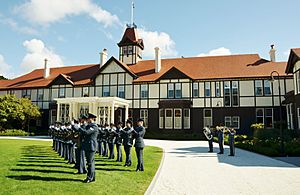
Cost
The New Zealand Government pays for the governor-general's expenses. This costs about $4.3 million per year. Some groups argue the cost is higher, including building upgrades.
Salary
As of 2024, the annual salary is NZ$440,000. This amount is subject to income tax since 2010. The Governor-General Act 2010 now sets the salary.
Homes and Staff
The governor-general's main home is Government House, Wellington. There is also a smaller home in Government House, Auckland. Government House in Wellington was closed for major renovations from 2008 to 2011. In 2012, Prince Charles opened a visitor centre there.
The governor-general's staff helps with their duties. All staff are public servants within the Department of the Prime Minister and Cabinet.
Transport
Since the 1960s, the New Zealand Government has provided an official state car. This car transports the governor-general for official business. It is also used for other officials and visiting leaders. The governor-general's official car has a special symbol of St Edward's Crown instead of number plates. The current official car is a BMW 7 Series.
Symbols
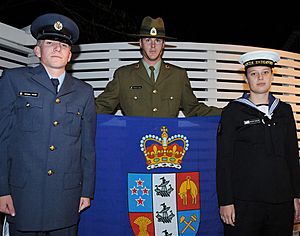
The governor-general's flag can be flown from their car or from a building where they are present. This flag was adopted in 2008. It is blue with the shield of the New Zealand coat of arms and a crown in the center. It is more important than the national flag. The national flag is usually used when the governor-general travels abroad. The national flag is also flown at half-mast when a current or former governor-general dies.
The flag's design matches the badge of the New Zealand Order of Merit. Only the King and the governor-general can wear this badge.
A special musical greeting, called a viceregal salute, is played for the governor-general. It uses the first six bars of "God Save the King".
Titles and Rank
In New Zealand's official ranking, the governor-general is second only to the King. The governor-general and their spouse are called "His/Her Excellency" while in office. The governor-general is also called "The Right Honourable" for life after leaving office. Since 2006, former governors-general can use the title "the Honourable".
The current governor-general holds titles like Chancellor of the New Zealand Order of Merit and Principal Companion of the King's Service Order. The governor-general is also titled Sir or Dame.
Official Clothing
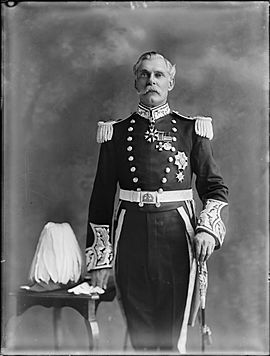
The governor-general has a special ceremonial uniform. It is a dark navy coat with silver embroidery and buttons. It includes trousers with silver braid, a sword, a special hat with feathers, and boots. There is also a white version for tropical weather.
This uniform has not been used much since the 1980s. This was partly because Sir Paul Reeves, a religious leader, chose not to wear a military uniform. The traditional uniform was seen as a reminder of colonial times. Now, the governor-general usually wears a black suit for men or a formal dress for women. They might wear a military uniform if they are already entitled to it.
History of the Role
Early Governors
From 1832, James Busby was the official British representative in New Zealand. He helped write the Treaty of Waitangi. This treaty established British rule. Captain William Hobson was appointed lieutenant-governor of New Zealand in 1840. At that time, New Zealand was part of the colony of New South Wales. Hobson is often seen as the first governor of New Zealand. However, Sir George Gipps was the first governor over New Zealand. This was only in his role as governor of New South Wales. New Zealand became a separate colony in 1841. Hobson remained in office until his death in 1842.
Captain Robert FitzRoy replaced Hobson. FitzRoy found it hard to keep peace between Māori and settlers. He had limited money and soldiers. The first armed conflicts of the New Zealand Wars began during his time. FitzRoy supported Māori claims over land deals. This led to his dismissal in 1845.
FitzRoy's replacement, Sir George Grey, is considered a very important governor. Grey was the last governor to act without needing parliament's approval. During his first term (1845–1852), Grey asked the British Parliament to change the New Zealand Constitution Act 1846. He wrote his own constitution bill, which became the New Zealand Constitution Act 1852. Grey's first term ended before New Zealand had its own responsible government.
The job of overseeing the change to responsible government fell to Robert Wynyard. He opened the 1st New Zealand Parliament in 1854. Parliament quickly demanded the power to choose ministers. Wynyard refused at first. He then allowed some elected members into the Executive Council. But parliament still wanted full power. The next governor, Sir Thomas Gore Browne, arrived in 1855. During his time, responsible government was introduced. This limited the governor's powers. The governor now had to work with a premier and their ministers.
Sir George Grey returned for a second term in 1861. He struggled to balance the needs of the colonial and British governments. The New Zealand Wars brought many British troops to New Zealand. Grey tried to keep them there, against British orders. He was recalled in 1868.
After Grey, later governors were from British noble families. They played a less active role in government. Only a few times did a governor refuse the premier's advice. One famous example happened when Sir Arthur Gordon was governor. In 1881, while he was away, Premier John Hall advised the Chief Justice to order an invasion of a Māori village at Parihaka. The Governor had been against this.
Governors-General
British Representatives
In 1907, New Zealand became a dominion. This led to new documents in 1917 that reduced the governor's powers. To show these changes, the office was renamed governor-general. Arthur Foljambe, 2nd Earl of Liverpool, the current governor, became the first governor-general.
In 1926, the Balfour Declaration defined British Commonwealth countries as freely associated. This meant the governor-general became a regal position. They had all the theoretical powers of the King. New Zealand officially adopted this in 1947 with the Statute of Westminster Adoption Act 1947.
Even before 1947, the governor-general's role as a British government representative slowly decreased. For example, from 1939, the high commissioner of the United Kingdom to New Zealand became the main British diplomat in New Zealand.
In 1945, Prime Minister Peter Fraser suggested that Sir Bernard Freyberg, a British-born commander of New Zealand's forces, be appointed. Until 1967, British officials chose governors-general. They consulted with the New Zealand prime minister, who then recommended them to the King.
New Zealand Citizens in the Role
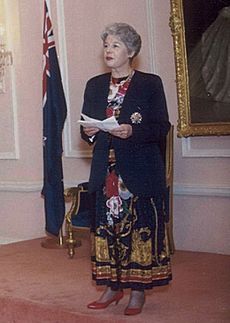
In the 1960s, the British government suggested that the New Zealand prime minister should choose the governor-general. A poll found that 43 percent of New Zealanders preferred Britons for the role. 41 percent preferred New Zealanders.
In 1967, Sir Arthur Porritt, the first New Zealand-born governor-general, was appointed. This was on the advice of Prime Minister Keith Holyoake. Sir Denis Blundell followed in 1972. He was the first governor-general who was born and lived in New Zealand. Appointing New Zealand citizens raised concerns. People worried that the governor-general might become too involved in politics. This concern grew when former prime minister Sir Keith Holyoake was appointed in 1977. Despite this, Holyoake acted fairly.
In 1983, new letters patent were issued. These further reduced the office's powers. The new documents were signed by the New Zealand Prime Minister. This showed that the office was now truly New Zealand's own. The governor-general now oversaw the "Realm of New Zealand".
After a political event in 1984, the 1852 Constitution Act was replaced by the Constitution Act 1986. The governor-general's powers were further limited. For example, their power to refuse to approve laws was greatly reduced.
With the office becoming more New Zealand-focused, there was an expectation that officeholders would represent all New Zealanders. Since then, a more diverse group of governors-general has been appointed. Sir Paul Reeves (1985–90) was the first Māori governor-general. Dame Catherine Tizard (1990–96) was the first woman. Sir Anand Satyanand (2006–11) was the first of Indian and Pasifika descent. He was also the first Roman Catholic.
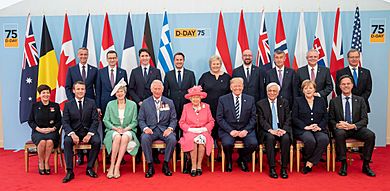
Since the late 1900s, the governor-general has taken on more duties of a head of state. They travel overseas, represent New Zealand at international events, and promote New Zealand's interests. The first such visit was in 1989 for the funeral of the Japanese emperor. New Zealand governors-general could not make state visits until 1992. That year, the King of Spain invited Dame Catherine Tizard for a State Visit. The Queen could not travel as Queen of New Zealand. So, it was agreed that governors-general could accept state visit invitations. But it had to be clear they were the King's representative.
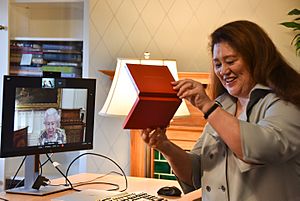
Discussions about changing the office often happen when people talk about New Zealand becoming a republic. Some suggest the governor-general's role needs to be updated.
Some experts worried that changes to the election system could give the governor-general more political power. In 1993, Governor-General Dame Catherine Tizard suggested this. She thought the governor-general might need to use their special powers more often under the new mixed-member proportional (MMP) system. This is because MMP elections often do not result in one party having a clear majority. After MMP was adopted, Prime Minister Jim Bolger suggested New Zealand might become a republic. He said this was because the governor-general would have more influence. In 1996, Governor-General Sir Michael Hardie Boys clarified how he would use his powers. He stated that politicians must decide who will govern. Only after their public announcement would he appoint a prime minister.
In 2009, a review recommended changes to the law for the governor-general. The most important change was that the governor-general would no longer be exempt from paying income tax on their salary. These changes took effect for the next governor-general's term.
In 2020, a poll found that 32 percent of New Zealanders thought the governor-general was the head of state. Only 18 percent knew the Queen was New Zealand's head of state.
See also
 In Spanish: Gobernador general de Nueva Zelanda para niños
In Spanish: Gobernador general de Nueva Zelanda para niños
- Letters Patent Constituting the Office of Governor-General of New Zealand
- List of governors-general of New Zealand
- Armorial of the governors-general of New Zealand
- List of official secretaries to the governor-general of New Zealand
- Spouse of the governor-general of New Zealand
- Government Houses of New Zealand
- Orders, decorations, and medals of the United Kingdom and New Zealand royal honours system for an explanation of honours


